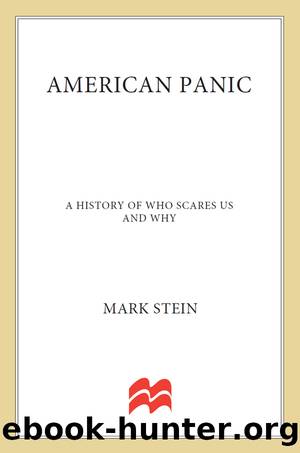American Panic by Mark Stein

Author:Mark Stein
Language: eng
Format: epub
Publisher: St. Martin's Press
Published: 2014-03-27T16:00:00+00:00
Nine
“WOMAN SUFFRAGE … revolution-
izes society … revolutionizes religion
… revolutionizes the Constitution and
… the legitimate and proper sphere of woman.”
—Speech in U.S. Senate by George Vest (D-MO), December 16, 18811
At first glance, many may find it difficult to perceive that women have ever been feared as a danger to the nation—let alone the cause of widespread panic over that fear. Though the proverbial “battle of the sexes,” which included resistance to giving women the vote, has been fought throughout American political history, has there actually been panic? When one considers that no other group has had as many legal restrictions for as long as women; that wives did not begin to acquire property rights or any rights regarding child custody until the mid-nineteenth century; and that not until 1920 did the Constitution provide that women had the right to vote, an outline begins to surface that resembles the other panics discussed. Clearly, there has been concern regarding women as a danger to the nation. As we unearth those past concerns, we will discover that whenever women have openly sought to confront them, there has been panic. While the elements of the panic are the same in this instance as in others, in this instance widespread panic has surfaced solely as backlash. So particular is this aspect that Pulitzer Prize–winning journalist Susan Faludi explored it in her 1981 book Backlash: The Undeclared War Against American Women. It is not, however, unique to women, as will shortly be seen in the panic over homosexuals.
“I desire you would remember the ladies and be more generous and favorable to them than your ancestors,” Abigail Adams wrote her husband in 1776. As John Adams joined with other American colonists to declare a new and independent nation, his wife entreated, “Do not put such unlimited power into the hands of husbands. . . . If particular care and attention is not paid to the ladies, we are determined to foment a rebellion, and will not hold ourselves bound by any laws in which we have no voice or representation.”2 The future second president of the United States responded, “You are so saucy.” Adams then admitted to his wife, “We know better than to repeal our masculine systems . . . which would completely subject us to the despotism of the petticoat.”3
The limitations against which Abigail Adams was pushing were articulated one decade earlier in Sermons to Young Women, a two-volume collection of homilies by Reverend James Fordyce. Though Fordyce was Scottish, Americans so highly regarded him that his book was published, and repeatedly republished, in the United States. In it, he advised the ladies, “Your business chiefly is to read men, in order to make yourselves agreeable and useful.”4 While Abigail Adams displayed political insight as keen as that possessed by the men who signed the Declaration of Independence, she confined herself to the prescript Fordyce advised—“reading” her husband and making herself “useful”—but never went public with her very non-Fordycian feminist views. In pushing those
Download
This site does not store any files on its server. We only index and link to content provided by other sites. Please contact the content providers to delete copyright contents if any and email us, we'll remove relevant links or contents immediately.
| Elections & Political Process | Ideologies & Doctrines |
| International & World Politics | Political Science |
| Public Affairs & Policy | Specific Topics |
| United States |
The Secret History by Donna Tartt(18865)
The Social Justice Warrior Handbook by Lisa De Pasquale(12143)
Thirteen Reasons Why by Jay Asher(8802)
This Is How You Lose Her by Junot Diaz(6804)
Weapons of Math Destruction by Cathy O'Neil(6152)
Zero to One by Peter Thiel(5694)
Beartown by Fredrik Backman(5609)
The Myth of the Strong Leader by Archie Brown(5429)
The Fire Next Time by James Baldwin(5253)
How Democracies Die by Steven Levitsky & Daniel Ziblatt(5134)
Promise Me, Dad by Joe Biden(5090)
Stone's Rules by Roger Stone(5029)
A Higher Loyalty: Truth, Lies, and Leadership by James Comey(4851)
100 Deadly Skills by Clint Emerson(4845)
Rise and Kill First by Ronen Bergman(4706)
Secrecy World by Jake Bernstein(4653)
The David Icke Guide to the Global Conspiracy (and how to end it) by David Icke(4629)
The Farm by Tom Rob Smith(4442)
The Doomsday Machine by Daniel Ellsberg(4421)
